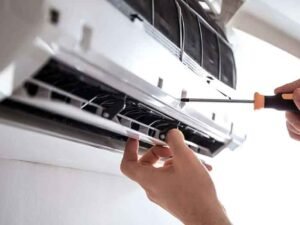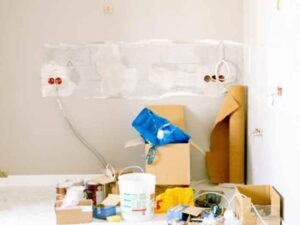Home improvement projects can be incredibly rewarding. Whether you’re renovating your kitchen, adding a new deck, or tackling a smaller DIY project like painting a room, the sense of accomplishment that comes with transforming your living space is unmatched. However, before you pick up that hammer or power tool, it’s crucial to take safety seriously. Protecting yourself while working on home projects should always be a priority to avoid accidents and injuries.
In this article, we’ll go over the essential safety gear every homeowner needs to ensure they stay safe while improving their space. From personal protective equipment (PPE) to cleaning supplies, we’ve got you covered. Let’s dive into the must-have safety gear for any DIY enthusiast or home project manager.
1. Safety Glasses or Goggles
One of the most important items to wear when doing any kind of work around the house is safety glasses or goggles. Flying debris, dust, and splinters are common hazards when cutting, drilling, sanding, or grinding. If you’re doing construction work or even just using power tools like a saw, safety goggles can protect your eyes from potential injury.
For tasks like sanding, grinding, or working with chemicals, consider investing in goggles that offer a better seal around the eyes for extra protection. It’s also a good idea to look for glasses with UV protection if you’ll be working outdoors. For more information on custom hard hat imprints, visit safetysourcellc.com.
2. Hearing Protection
Noise levels on construction sites or even during small DIY tasks can be dangerously loud. Prolonged exposure to high-decibel sounds can lead to hearing damage. Whether you’re using a power saw, hammering, or working with a loud drill, ear protection is a must.
There are several types of hearing protection available, from earplugs to earmuffs. For light tasks, earplugs might suffice, but if you’re working on a larger project or using tools that create a significant amount of noise, over-the-ear earmuffs will provide better protection.
3. Work Gloves
Another essential piece of safety gear is a good pair of work gloves. Gloves protect your hands from sharp objects, splinters, heat, and chemicals, making them crucial for virtually any home improvement project. Depending on the type of work you’re doing, you’ll want to choose gloves that are durable yet comfortable.
For tasks like painting or handling hazardous chemicals, you might opt for gloves made from rubber or latex. If you’re working with rough materials like wood or metal, gloves made from leather or synthetic materials may provide the best protection against cuts and abrasions.
4. Dust Mask or Respirator
Dust, mold, and other airborne particles can pose a serious risk to your health if inhaled over time. Whether you’re sanding wood, scraping old paint, or working in a poorly ventilated area, it’s essential to protect your lungs with a dust mask or respirator.
Basic dust masks are often enough for light sanding or working with drywall, but if you’re dealing with more harmful substances like asbestos, mold, or toxic fumes, consider using a more heavy-duty respirator with a filter to protect against hazardous particles.
5. Knee Pads
When you’re working on the floor, whether it’s installing tiles, carpeting, or laying down hardwood floors, kneeling for extended periods can take a toll on your knees. To prevent discomfort and potential knee injury, a pair of knee pads can make all the difference. Look for knee pads that offer adequate padding and stay in place as you move around. They’ll help protect your knees from strain and damage, allowing you to work for longer periods without discomfort.
6. Steel-Toe Boots
For many home improvement projects, especially those involving heavy lifting or construction work, sturdy footwear is crucial. Steel-toe boots provide additional protection to your feet and toes in the event that something heavy falls or is dropped. They also offer support to prevent ankle injuries when you’re standing or walking on uneven surfaces.
While they can be heavy, steel-toe boots are a must-have for anyone working with tools or materials that could cause injury. Look for boots that are also slip-resistant for added safety, particularly if you’re working in wet or slippery environments.
7. Hard Hat
A hard hat is one of the most critical pieces of safety equipment when working on construction projects or in environments where there’s a risk of falling debris. While you might not always need one for smaller DIY projects, if you’re working on a major renovation or working around contractors, it’s a good idea to have a hard hat on hand.
The best part about hard hats is that they don’t just provide protection – they can also be personalized with logos or designs. The Safety Source LLC offers custom logo imprinting on hard hats, making it easier for companies or individuals to both ensure safety and promote branding at the same time. Hard hats are lightweight, durable, and crucial for protecting your head from falling objects or accidental impacts.
8. Fall Protection Gear
If your project involves working at height—whether it’s on a ladder, scaffolding, or a rooftop—fall protection gear is essential. This could include a harness, safety lines, and a fall arrest system. Falls are a leading cause of injury in home improvement projects, so having the proper equipment to prevent a fall can save your life.
Ensure that your ladder is stable before use, and always secure yourself with a safety line when working at elevated heights. It’s better to be cautious and prepared, especially if you’re not experienced with working at heights.
9. Fire Extinguisher
A fire extinguisher is another essential safety item, especially if you’re working with any materials or tools that could spark a fire. Whether you’re cutting wood, soldering pipes, or working with flammable chemicals, it’s important to have a fire extinguisher nearby. Be sure it’s suitable for the types of materials you’re working with (e.g., a Class ABC extinguisher can handle most household fires).
10. Cleaning Supplies
After finishing your home improvement project, it’s important to clean up thoroughly. Not only does this maintain a neat and tidy work environment, but it also eliminates any lingering hazards. Have a few essential cleaning supplies on hand, such as gloves, sponges, cleaning cloths, and a mop or broom. In some cases, you may also want to have industrial-strength cleaners for tougher jobs, such as removing paint or sticky residue.
Having quality cleaning supplies is just as important as having the right PPE, and it’s often something that’s overlooked when planning a project. Keep your space clean and clear of hazards to avoid accidents and injuries once you’re done with the work itself.
Conclusion
Taking the proper safety precautions during home improvement projects isn’t just about following regulations – it’s about ensuring your own well-being. The right safety gear can help prevent injuries, keep you productive, and ensure you enjoy the process of transforming your space. Whether you’re tackling a minor DIY project or a major renovation, make sure to invest in the proper equipment.
From safety glasses to hard hats and fall protection gear, every home project requires specific tools to keep you safe. Stay safe and make your home improvement projects enjoyable and injury-free!










